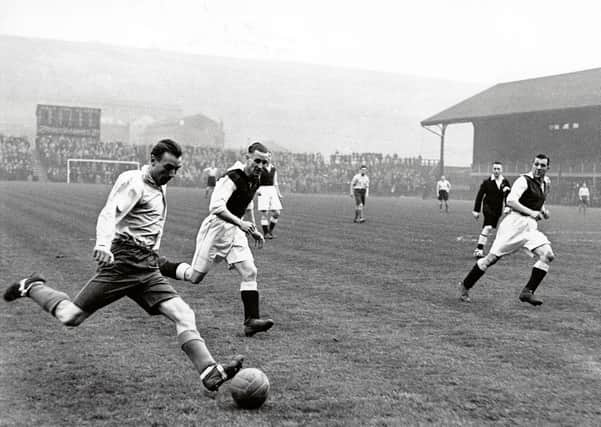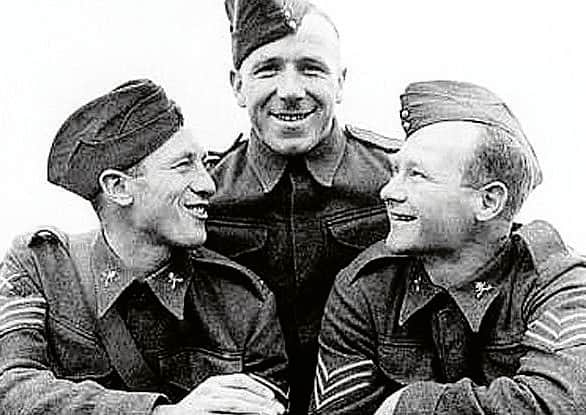Rangers dominated wartime football but should their titles be recognised in the record books?


However Scottish football is reassembled when the coronavirus pandemic does eventually subside, decisions taken over how to settle the outstanding issues of the 2019-20 campaign will be inevitably subject to feverish debate.
And if any proof were required as to the ceaseless arguments that can ensue from global events shutting down football, a petition started in 2017 might be a decent starting point. It came from a Rangers supporter who called on the Scottish football authorities to recognise the 12 trophies the Ibrox club won during the years of the Second World War when no official football competitions ran.
Advertisement
Hide AdAdvertisement
Hide AdThe desire of this fan to have his club “going for 61” doesn’t quite equate with the form of the game that did ensue from Britain declaring war on Germany on 3 September, 1939. A mere day after a full card in the Scottish League – the fifth round of matches in that aborted season – concluded with clubs that had travelled distances to play dashing home in order to beat the first night of the blackout.


The fact the blackout of football lasted fewer than two months is indicative of the hold the game held over the nation – and the government’s assessment as to the purpose it could serve. It was considered games would boost morale and prevent boredom setting in which, it was feared, could give way to social disorder.
The football played in the war years across this country – the Scottish League suspended any tournaments under its direct auspice until 1946-47, the end of hostilities in 1945 coming too late for a normal league format then to reintroduced – was chronicled with typical flair and forensic focus by peerless game historian Bob Crampsey in his centenary history of the Scottish Football League.
What he picks apart is not the sport as we know it, or as existed before Germany invaded Poland. It is a period of ever-changing league formats and star-embossed teams courtesy of stellar English-based players stationed in Scotland – the likes of Matt Busby, Stanley Matthews, Tommy Lawton and Frank Swift – guesting for clubs, and a dominance by Rangers that they would only enjoy again in the 1990s. A dominance helped, not so much by their players finding reserved employment in the shipyards as is still grumbled over, but weak refereeing. On the latter matter, Crampsey cites a Daily Record columnist who was moved to declare: “Rangers might not want favours from referees, but they certainly get them.”
Yet the Ibrox club were the true architects of their own success. Driven by über-manager Bill Struth’s belief that it was a patriot’s duty to deliver footballing entertainment during a time of strife, their attitude to wartime football contrasted with Celtic’s. A complete irrelevance during this period, the east end of Glasgow club were rudderless after jettisoning the godfather figure of Willie Maley. His three-decade, 30 major trophy managerial career was ended against his wishes during the first war league. Celtic were further hampered by their unique refusal to play guest players, losing Celtic-daft Busby to Hibernian as a result.
The initial league set-ups established in September 1939 were curious in their parameters. The desire not to have clubs travelling far because of transport and safety issues led to the formation of regional West and East leagues, each with 16 teams. That meant teams being set aside. Brechin City, Forfar Athletic, Edinburgh City, Leith Athletic and East Stirling were the unfortunates. It was decided two of the smaller Edinburgh clubs had to give up a senior league presence and Leith lost out to St Bernards on the toss of a coin.
Separating east from west meant Hearts, Hibs and Aberdeen being detatched from Glasgow’s big two and their gate receipts. The decisions resulted in the Tynecastle club immediately expressing concerns over their ability to remain solvent. Sound familiar? That came even as the SFA declared all players’ contracts void only three days after the country had entered the war.
Scotland did become a mecca for guests, though, because the maximum wage of £2 per week was almost double that on offer from the English game, at least until 1943.
Advertisement
Hide AdAdvertisement
Hide AdCrowds for the 1939-40 campaign, as it was, weren’t sufficient to prevent most clubs losing money, Celtic posting the biggest losses. Only three clubs made a profit, Rangers foremost among them. Much has been made of the Ibrox club retaining their players while such as Hibs, with 30, and Motherwell, who had 13, delivered many men to the front. Celtic supporters of a certain vintage will argue blind their club lost many influential players in contrast to their ancient rivals. Yet Crampsey notes that both clubs were criticised for the “microscopic contribution” they made to the war effort in this respect. He states that, of the 22 players that were regular first-teamers immediately before the war, only two from each “ended up in uniform”. Rangers’ Willie Thornton did so with enormous distinction, earning a Military Medal for his valour in Sicily.
The disquiet of clubs in the east to the west/east format meant they rejected its continuation into the 1940-41 season. As a result, Hibs and Hearts joined the Southern League then established. It meant Aberdeen being left high and dry because then Tayside big hitters Dundee had no interest in playing wartime football, a disinclination shared by St Johnstone, who rented out Muirton Park so they couldn’t be co-opted. A northern league didn’t get off the ground at that stage even in the face of the SFA, in unprecedented fashion, stating they would cover any losses incurred by clubs. Meanwhile, Kilmarnock were placed on ice because Rugby Park was requisitioned for fuel storage by the army, who rebuilt it following the war.
Supporters started to rediscover their appetite for football as the war dragged on, and so did teams in the north. By 1941-42, a Northern League was established, with Rangers having such a big squad they fielded a reserve team in it. And won it… at least the spring version, with the autumn edition claimed by Aberdeen. Football was played 11 months of the year then.
It was during this period that guest players really began to bring colour to the Scottish game. Matthews turned out for Morton and Airdrie before playing a couple of games for Rangers. His Ibrox days produced a curious symmetry. His wife Betty was the grandchild of Tommy Vallance, sometimes known as one of the club’s “gallant pioneer” founders, despite actually joining the fledgling Rangers one year into their existence. Busby, meanwhile, proved to be a key figure in the post-war rise of Hibs, thanks to his posting with Scottish Command.
The Bellshill-born sergeant was desperate to play for Celtic but they would not drop their opposition to selecting army weekenders, and their loss proved the Leith club’s gain. The great Liverpool inside forward played 40 games in Hibs colours, a Summer Cup win over Rangers his most notable outing, Another cup final against the Ibrox men was lost on the toss of a coin after it finished goalless and the other deciding factor, corners, was a 2-2 tie. More than that, though, Busby was considered to have proved a crucial mentor to the teenage Gordon Smith. The subsequent Famous Five icon made his senior breakthrough as a trialist during the war years and, aged only 16, announced his arrivial when he scored twice to help Hibs to an 8-1 win over Rangers in May 1941.
Other oddities were seeing English international keeper Swift front up at Hamilton Accies, his Three Lions team-mate Tommy Lawton appear for Morton, Bill Shankly guest for Partick Thistle and Stan Mortensen, inset, do a decent turn for Aberdeen. To name but a few.
The desire to have such fabled performers cost St Mirren dearly, however. They were fined for illegal inducements to Everton’s Jimmy Caskie and Manchester City’s Leslie McDowall – as were the two players – and five of their seven directors received lifetime bans from football activity.
An unedifying episode – the Paisley club made a scapegoat for a transgression then common – the same could be said of the large-scale riot that came during a Rangers and Celtic game in September 1941. That led the Glasgow Lord Provost Sir Patrick Dollan to implore the chief constable – who decided upon the staging of fixtures and ground capacities – to call a halt to the teams’ meeting until after the war.
Advertisement
Hide AdAdvertisement
Hide AdThe unreal times were betrayed by the fact that a complaint to Morton by Clyde over the length of their grass in June 1941 was rebuffed with the revelation that the mower blades had been chipped by shrapnel left on the pitch following bombing days earlier. Equally, the fact that clubs were appealing to fans for their clothes coupons within the year after obtaining kit had become arduous as the result of rationing told all was so very far from normal.
Celtic would be relieved this was so after losing 8-1 to Rangers in the new year derby of 1943, the Parkhead club not even fussed about retaining players despite starting to turn a profit as crowds ramped up.
By the following season, Dundee were back in the fold following a fear that to do otherwise might result in their closure. Their jolt back to life came as a consequence of local businessmen embarking on a failed summer 1943 bid to buy Dens Park and turn it into a greyhound track.
They showed what a miss they had been by posting record attendances in the now-renamed North-Eastern League. A crowd of 15,000 turned out for a derby meeting with neighbours United.
The Rangers juggernaut continued in the Southern League and Struth’s determination to maintain standards during the war had much to do with the domination that the Ibrox club continued to hold when the Scottish League came back into being in 1946-47. Hibs and Aberdeen became their principle rivals in the immediate post-war period because they too sought to develop players and their team structures.
Scottish football’s war years did have one undoubted success, though, that can be deemed official. The desire to fill blank weekends created by the 30-game structure of the Southern League was behind the formation of the Southern League Cup. It took the form of four sections of four teams (Northern League teams weren’t allowed to compete in it until 1945-46) to decide semi-finalists. Essentially the forerunner of a League Cup that was first contested in 1946-47, the war lies behind why it remains part of the Scottish football calendar eight decades later. However, whatever petitions might be brought forth, history shows there is no rationale for placing Scottish football’s war efforts into the official record books.